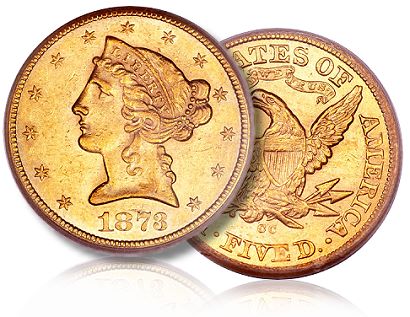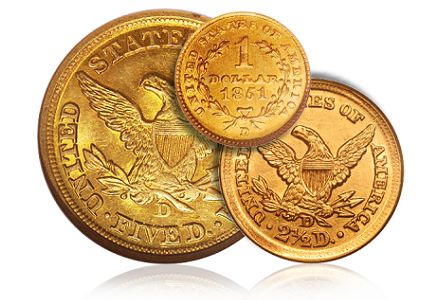by Doug Winter – RareGoldCoins.com
For many 19th century gold issues, it is as important to know the grade distribution as it is the overall rate of survival. In this blog, let’s look at grade distribution; namely how the surviving examples of a specific issue are distributed along the lines of grade.
It is natural to believe that for the typical mid-19th century issue grade distribution, if plotted on a graph, would resemble a bell curve. If, say, 100 examples of a specific issue are known, it is likely that few survivors would be in very low grades (i.e. VF and below) and few would be in high grades (i.e., Mint State), with most clustered in the middle grades (i.e., EF and AU). To some extent this is true but there are a number of scenarios that can make the grade distribution skew more towards the low end or the high end.
 Grade distribution can cluster towards the low end for a number of reasons. One has to do with the need for coins in a particular geographic region. The gold coins from Carson City were eagerly received by citizens of the western states from 1870 through 1874 due to a pressing need. As an example, nearly every known 1873-CC half eagle and eagle grade Extremely Fine or below, indicating that these were issues that saw considerable use in circulation.
Grade distribution can cluster towards the low end for a number of reasons. One has to do with the need for coins in a particular geographic region. The gold coins from Carson City were eagerly received by citizens of the western states from 1870 through 1874 due to a pressing need. As an example, nearly every known 1873-CC half eagle and eagle grade Extremely Fine or below, indicating that these were issues that saw considerable use in circulation.
There are other issues that tend to be found in lower grades due to heavy use in circulation. These include the Charlotte and Dahlonega quarter eagles and half eagles from the first few years that these mints were open (1838 to around 1843), San Francisco half eagles and eagles from the late 1850′s through the mid-1860′s and New Orleans half eagles and eagles from the mid to late 1850′s.
You will note that all of the issues that I have mentioned so far tend to be medium to larger sized; they don’t include gold dollars, quarter eagles and double eagles. For various reasons, these denominations do not necessarily show the same grade distribution pattern as do their larger-sized counterparts from the same era.
Grade distribution tends to be a size-related phenomenon. Because of their size, Double Eagles did not to circulate as much as half eagles or eagles and because of their intrinsic value they were melted to a greater extent in later years. With the exception of certain rare dates like the 1854-O and 1856-O, most double eagles of the Type One design are seldom found in grades below EF.
The same is true with gold dollars. Because of their small size, the likelihood of a gold dollar circulating all the way down to the VF grade range is improbable.
Let’s go back to two issues I mentioned above and look at their grade distribution.
The 1873-CC half eagle is an issue that saw heavy circulation in the local economy and, as a result, is typically seen in low grades. PCGS has graded a total of 65 examples of which only 7 (or a shade over 10%) grade above AU50.
Now compare this to the 1893-CC half eagle, a more common issue but one that saw very little circulation in the local economy. PCGS has graded a total of 364 in all grades of which a whopping 283 (or over 80%) grade AU50 or better.
This situation also exists for the 1873-CC eagle. PCGS has graded a total of 52 of which just 14 are considered high grade coins (i.e., AU50 and above). Compare this to the 1881-CC eagle, an issue that saw little local circulaton and is now often repatriated in groups from Europe. This date has a a total population at PCGS of 264 with 137 of them, or more than 50%, in high grades.
Certain rare date 19th century gold coins have a grade distribution that makes sense because of very low original mintage figures. As an example, well-known rarities such as the 1864 quarter eagle, 1875 half eagle and eagle and 1883-O eagle are very rare in higher grade because they have tiny original mintage figures. The likelihood of a coin surviving in higher grades with an original mintage of 100 or 200 (the 1875 eagle and half eagle, respectively) is, obviously, very slim.
 But mintage figures alone do not act as a predictor of a coin’s rarity. There are certain later 19th century issues, such as the Three Dollar gold pieces from the 1880′s, that have very low mintage figures but high survival rates. These issues were saved by collectors, dealers and speculators when they were struck and not only do they exist in far greater percentages than their counterparts from the 1860′s and early 1870′s, but in higher average grades as well.
But mintage figures alone do not act as a predictor of a coin’s rarity. There are certain later 19th century issues, such as the Three Dollar gold pieces from the 1880′s, that have very low mintage figures but high survival rates. These issues were saved by collectors, dealers and speculators when they were struck and not only do they exist in far greater percentages than their counterparts from the 1860′s and early 1870′s, but in higher average grades as well.
What about low mintage issues that are more available in high grades than expected due to hoards? A good example of this is the 1857-D quarter eagle. With a mintage of just 2,364 you would expect this to be a rare coin in all grades. Most Dahlonega quarter eagles have a survival rate of around 3% of the original mintage. This is not the case with the 1857-D.
According to the most recent PCGS population figures, a total of 67 have been graded. Of these, no less than 57 have been graded AU or higher. How can we explain this anomaly?
If you are a student of Dahlonega quarter eagles, you are aware of the fact that most 1857-D quarter eagles (at least the ones that are original) have a similar look: softly struck, very frosty and toned in a rich yellow-gold hue. This similarity in appearance suggests that a hoard of 1857-D quarter eagles existed at one time and has been dispersed.
The grade distribution of an issue can change quickly due to hoards. A great example is the 1857-S double eagle. At one time, this issue was typically seen in EF and AU grades and was actually quite scarce in Uncirculated. But after thousands of high grade examples were located in the S.S. Central America treasure, the grade distribution of this date changed radically. Now, the 1857-S double eagle is seen more often in higher grades than it is in lower grades. The result of this was a radical compression of value. In MS62 or MS63, this date is only worth around three times more than it is in AU55 to AU58. Prior to the discovery of thousands of Uncirculated examples, this ratio was more like ten to one.
I believe that it is important for the student of United States gold coinage to study the grade distribution. By learning how rare a specific coin is in higher grades, the collector can identify the best values in the area(s) in which he collects. Because of third-party grading certification data, this is better possible than ever before.




